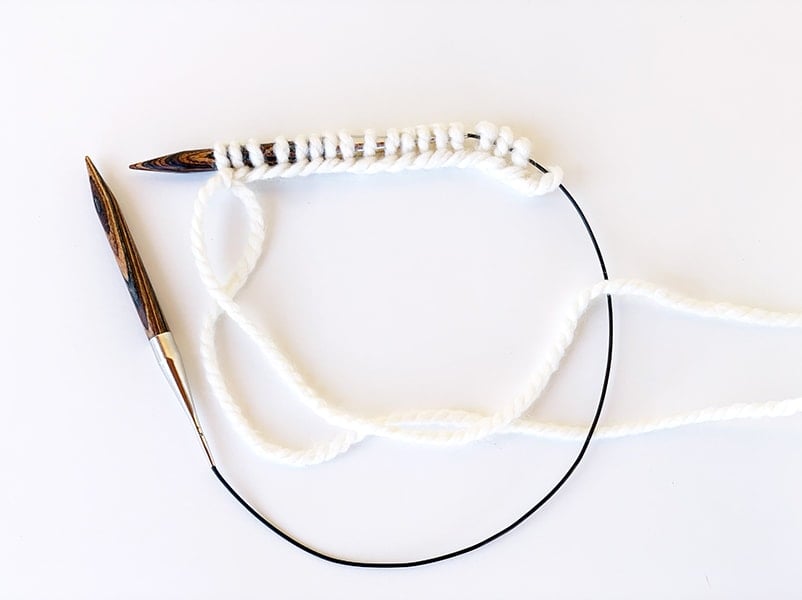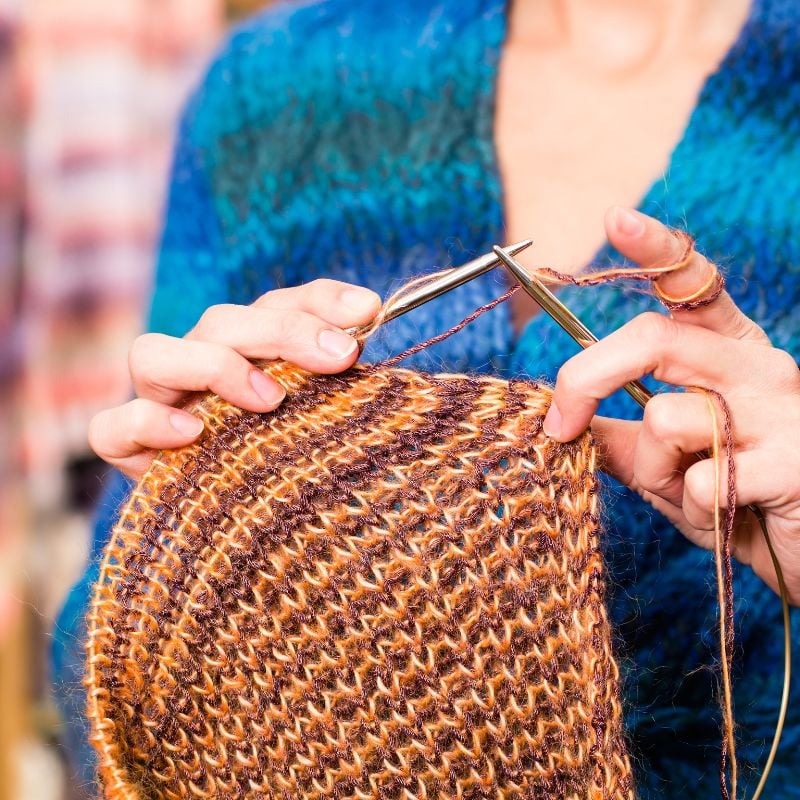Magic Loop Knitting: A Simple Step-by-Step Tutorial
THIS ARTICLE CONTAINS AFFILIATE LINKS THAT SUPPORT HANDY LITTLE ME CONTENT AND FREE PATTERNS.The magic loop technique is a fantastic way to knit in the round, especially for smaller projects like socks, mittens, sweater sleeves, or the crown of a hat.
If you’ve struggled with double-pointed needles (DPNs) or find short cables too limiting, this great alternative allows you to work seamlessly with a long circular needle instead.
In this blog post, I’ll walk you through the magic loop method step by step, with a photo tutorial and a video tutorial to guide you.
Whether you’re an experienced knitter or just starting out, mastering this knitting technique will open up new possibilities for your knitting projects.

Why Use The Magic Loop Method?
The magic loop knitting technique is ideal for small circumference knitting when you don’t have the right size circular needles or if your cable length isn’t short enough.
Instead of switching to DPNs, you can knit small tubes with a long cable, making the process smoother and more efficient.
This method is perfect for:
- Knitting socks (especially the second sock)
- Mittens and fingerless gloves
- Sweater sleeves
- Hats – including decreasing at the crown of a hat
- Small items like baby booties or stuffed toys
With a long circular needle (usually 32 inches or longer), the loops of cable allow you to work even the smallest circumference without any gaps.
This results in even tension, fewer tension issues, and a seamless finish.

Video Tutorial: Learn The Magic Loop in Action
Watch the following video tutorial, where I demonstrate the magic loop method step by step.
This tutorial video will show you exactly how to cast on, knit, and continue working in the round using this knitting technique.
📺 Watch now on my YouTube channel!
Time needed: 1 day, 2 hours and 30 minutes
Magic Loop Knitting: A Step-by-Step Guide for Small Circumference Projects
- Cast On the Required Number of Stitches
Before you begin, make sure you have the right needle size and a flexible cable at least 32 inches long (such as Addi Turbo or other smooth circular knitting needles).
Cast on the required number of stitches for your project.
Make sure you have an equal number of stitches on the left needle and the right needle tip for balanced knitting.
(For this tutorial, I cast on 18 stitches) - Divide the Stitches
Slide half of the stitches onto the front needle and the second half of the stitches onto the back needle.
Pull the center of the cable up to create a loop of cable sticking out on the left-hand side. - Arrange Your Stitches
Ensure the first half of the stitches are on the front needle and the back stitches rest on the side of the cord.
- Arrange Your Yarn
Move your working yarn to the correct position: If knitting, keep it behind.
If purling, let it hang between the needles. - Knit The First Stitch
Pull the back needle so that the stitches move onto the top of the needle.
Insert the right-hand needle into the first stitch on the front needle and knit it. - Knit Across the Front Needle
Continue knitting across the first round of stitches until you reach the last stitch.
- Turning The Work
Once you have knit across the first row of stitches on the left needle, you can then turn your work.
Now, the unworked stitches facing you were on the right needle.
Pull the back needle – the one you just worked, so the just worked stitches are resting on the loop of the cord.
Then, slide the unworked stitches onto the front needle.
Keep working the yarn toward the back when you knit to the end of the next set of stitches. - Knit Across The Stitches
Bring the back needle around and knit the first stitch on the front needle.
Knit across all of the stitches on the front needle.
When you have completed these next stitches, you have just worked one round.
For the new round, you will continue to move the stitches to begin again. - Rotate and Repeat
Turn your work so that the unworked stitches are now at the front.
Pull the back needle again, shifting the stitches forward.
Slide the next set of stitches into position on the front needle.
Repeat these steps to continue knitting small circumference projects in the round!
Let’s Review the Magic Loop Technique
Now that you’ve learned the magic loop method, let’s address some common questions.
Why Not Use a Small Circular Needle?
While small circular knitting needles (like 9-inch circulars) are an option, they may not always work for smaller-diameter projects.
The magic loop provides more flexibility with needle length and ensures a comfortable grip—especially useful when knitting a small tube like socks or mittens.
Are There Other Ways to Knit Small-Diameter Tubes in the Round?
Yes! Here are a few:
- Double-Pointed Needles (DPNs): The traditional method for small circumference knitting.
- Two Circular Needles: Some knitters prefer to divide stitches across two new needles.
- Short Circular Needles: These work well for certain projects but can be difficult to maneuver.
The magic loop knitting technique is often the favourite method for seamless small projects because of its ease and efficiency.

Projects to Practice the Magic Loop Method
Now that you’re comfortable with this new method try it out with these free patterns from my own collection:
- Irish Moss Stitch Hat Pattern
- Free Sock Knitting Pattern (Easy + Simple For Beginners)
- Easy Mittens Knitting Pattern
- Ribbed Beanie Knitting Pattern {Unisex Mariner’s Hat}
- Outlander Brianna Fingerless Gloves Pattern
Each of these knitting patterns benefits from the magic loop technique, helping you create seamless small items without the frustration of tension issues.

Final Thoughts – Happy Knitting!
The magic loop method is a game-changer for small circumference projects, allowing you to knit effortlessly with a long circular needle.
Whether you’re making sweater sleeves, socks, or mittens, this technique eliminates the hassle of short cables and double-pointed needles, making circular knitting much easier.
Try it out today, and let me know in the comments if this is your favourite method for knitting in the round!
Happy Knitting! xoxo

More Knitting Tutorials & Free Patterns You May Like:
- How To Knit A Hat For Complete Beginners (+ Video Tutorial)
- How To Knit – A Complete Beginner’s Guide
- 20 Temperature Blanket Patterns (The Ultimate Guide)
- How To Knit A Hat With Circular Needles (Step-By-Step)
- 31 Free Baby Blanket Knitting Patterns (Easy Knit Blankets)
- How To Knit Baby Booties (Step-By-Step)
- Knitted Dog Sweater Pattern (3 Sizes)
- 12 Simple Knitting Stitches For Beginners
- How To PSSO In Knitting (Pass Slipped Stitch Over)
- What Is TBL In Knitting? (Knit Through The Back Loop)
- 37+ Patterns To Use Up Your Yarn Stash (Small Projects)
- Free Dog Sweater Knitting Pattern (Straight Needles)
- Super Easy Corner To Corner Baby Blanket Pattern (Knit)
- Easy Baby Sweater Knitting Pattern For Beginners
- How To Knit A Baby Hat (Straight Needles)
- Pumpkin Knitting Pattern (Beginner Friendly!)
- 8 Cable Stitch Knitting Patterns
- Free Knitted Heart Pattern (Easy + Quick Project)
- 20+ Fall Oversized Knits (Sweater Knitting Patterns)











